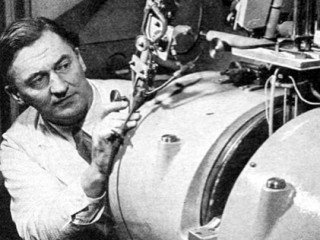
Hugo Theorell biography
Date of birth : 1903-07-06
Date of death : 1982-08-15
Birthplace : Linköping, Sweden
Nationality : Swedish
Category : Science and Technology
Last modified : 2011-01-04
Credited as : Scientist and biochemist, Nobel Prize laureate in medicine,
The Swedish biochemist Axel Hugo Theodor Theorell was awarded the Nobel Prize in Physiology or Medicine for his discoveries concerning the nature and mode of action of oxidation enzymes.
Hugo Theorell, the son of Ture Theorell, a medical practitioner, was born at Linköping, Sweden on July 6, 1903. From 1921 he studied medicine at the Karolinska Institute at Stockholm and graduated as a bachelor of medicine in 1924. He soon became an assistant in the Institute of Medical Chemistry at Stockholm, and there he was temporary associate professor in 1928-1929. In 1930 he graduated as a doctor of medicine and was appointed lecturer in physiological chemistry at the Karolinska Institute.
In 1931, while working in Svedberg's Institute of Physical Chemistry in Uppsala, Theorell was the first to obtain crystalline myoglobin, and he determined its chemical and physical properties. In 1932 he became associate professor of medical and physiological chemistry in the University of Uppsala; but from 1933 to 1935 he worked, as a Rockefeller Fellow, in the laboratory of Otto Warburg at Berlin-Dahlem. There he began his work on oxidation enzymes.
In 1932 Warburg and his coworker Walther Christian discovered in yeast a bright yellow enzyme. Warburg showed that it consisted of a yellow pigment and a carrier substance. When Theorell began working at Berlin, it was known that the pigment part was a flavin, called lactoflavin. It was later named riboflavin and was identified with vitamin B2. When separated from the carrier substance, which was itself inactive, the pigment part lost its enzymatic activity. At Berlin, Theorell, using his own electrophoretic methods, had by 1934 purified and crystallized the enzyme and had separated the pigment from the colorless protein carrier. He also showed that the pigment part—the coenzyme or prosthetic group—was a protein. He determined its constitution—a lactoflavin phosphoric ester—and named it flavin monouncleotide (FMN).
After his return to Sweden, Theorell was appointed in 1937 director of the new Biochemical Department of the Nobel Medical Institute in Stockholm. The department was transferred to a new Biochemical Institute in 1947.
Cytochrome was rediscovered independently in 1925 by David Keilin, who soon isolated cytochromes a, b, and c and showed that cytochrome c was fundamental in cell respiration. In 1938 Theorell showed that the heme nucleus of cytochrome c was linked to the protein in two different ways. This was the first occasion on which the nature of such linkages had been demonstrated in any enzyme.
In 1941 Theorell, working with à . à kesson, studied cytochrome cextensively, especially the mode of linkage of the iron to the protein and its stereochemical structure. In 1943 Theorell suggested that there were two steps in its reduction. In 1955 Theorell and Anders Ehrenberg showed that the core of the cytochrome c molecule consisted of an iron atom at the center, within a porphyrin disk bearing histidine side chains. The core was surrounded by helical peptide chains. Theorell thought the structure was designed to protect the iron from oxidizing agents—his theory of the "embedded heme." He was able to construct a model of the core.
In 1941 Theorell and his coworkers crystallized for the first time a peroxidase, found in horseradish, and in 1943 they isolated the lactoperoxidase in milk.
The alcohol dehydrogenases, oxidative enzymes consisting of a protein linked to diphosphopyridine nucleotide (DPN), are found especially in liver and in yeast. In 1948 the enzyme from horse liver was first crystallized in Theorell's institute, and in 1950 the velocity constant for the very rapid action of the liver dehydrogenase was determined. In succeeding years, Theorell and his coworkers elucidated the complicated action of the alcohol dehydrogenases. They found that the liver enzyme oxidized alcohol to aldehyde, whereas the yeast enzyme reduced aldehyde to alcohol. The later work of Theorell and his coworkers on these complex enzyme systems led to their development of a practically specific test for ethyl alcohol, used officially in medicolegal work.
For his discoveries on oxidation enzymes Theorell was awarded the Nobel Prize in 1955. In 1957 he was elected a Foreign Associate of the National Academy of Sciences in Washington and in 1959 a Foreign Member of the Royal Society. From 1967 to 1973, he was president of the International Union of Biochemists and in 1967-1968 president of the Swedish Academy of Sciences. A member of many foreign learned societies, he held honorary doctorates from seven universities. In 1960, he received the 150-Year Jubilee Medal of the Karolinska Institute and in 1965 the Paul Karrer Medal. In 1971, he received the Ciba Medal and the Semmelweiss Medal.
Interested in music all his life, Theorell was a member of the Swedish Royal Academy of Music and chairman of the Stockholm Symphony Society. His wife, Margit, was a professional pianist, and Theorell was a very accomplished violinist. Together, they were at the forefront of the musical life of Stockholm.
Theorell retired as director of the Nobel Medical Institute in 1970, after 33 years of service, although he continued to do research. Much of his work was done with long-time companion A. Akeson (1914-1988). Theorell died in Stockholm on Aug. 15, 1982.
There is a biography of Theorell in Nobel Lectures, Physiology or Medicine, 1942-1962 (1964), which also includes his Nobel Lecture. For references to his work see C. W. Carter, R. V. Coxon, D. S. Parsons, and R. H. S. Thompson, Biochemistry in Relation to Medicine (1959); M. Dixon and E. C. Webb, Enzymes (2d ed. 1964); and Dorothy M. Needham, Machina Carnis (1971).
















